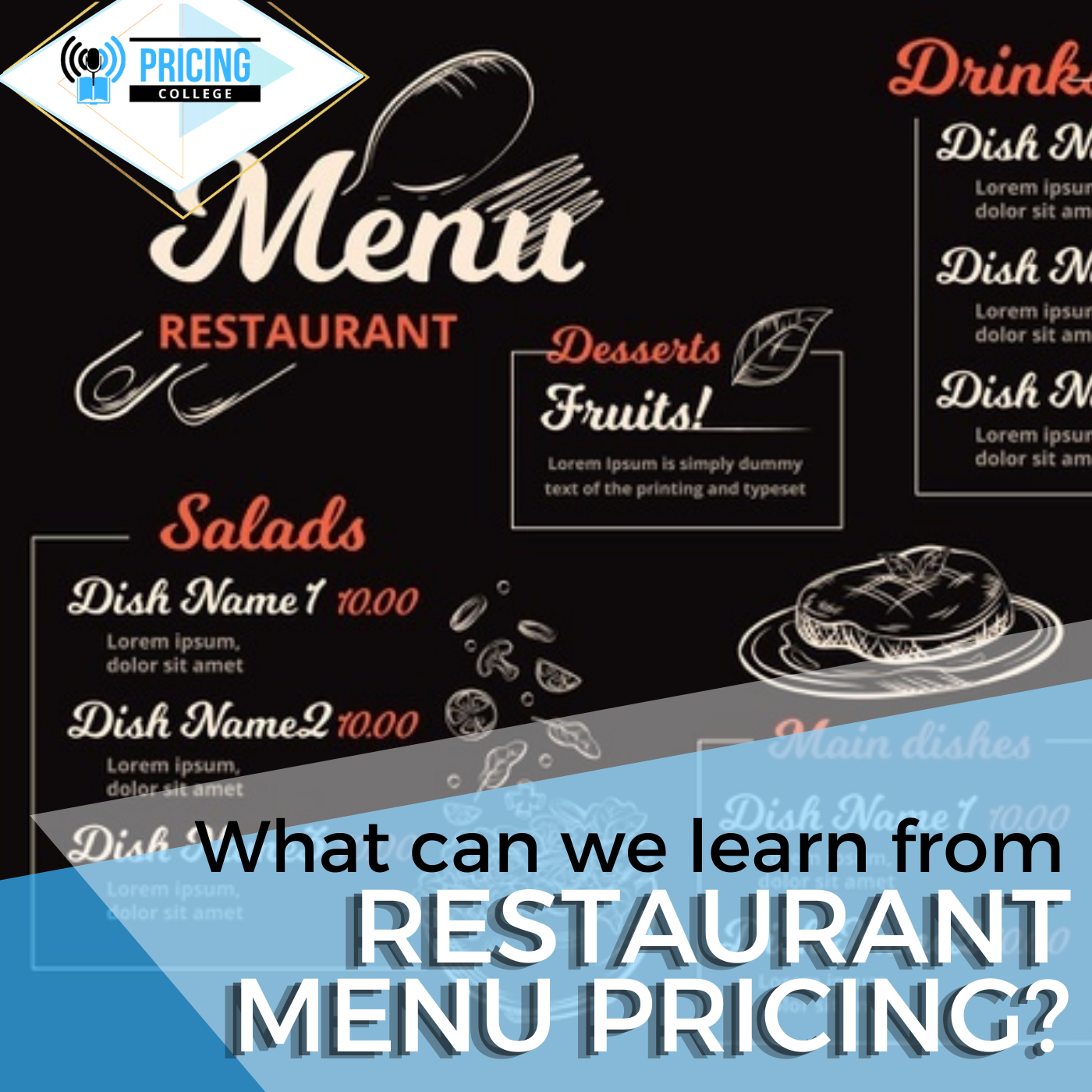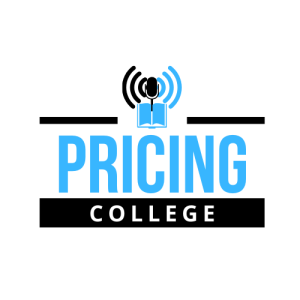
Episode #0023 - What can we learn from restaurant menu pricing?
 2020-07-15
2020-07-15
In this episode of Pricing College we celebrate getting back to restaurants and what tricks of the trade you can notice in restaurant menus.
Whether it is priced at $4.99 or just 5 without a dollar sign - the menu may be trying to manipulate you.
At least you have a defence now for eating too much at lunch!
Today we're going to talk about tips and tricks about menu pricing. Now when you go into a restaurant or when you look at a menu often you don't realise as a customer that there are certain things like pricing cues and psychological triggers being used in that menu price list. So we're going to discuss some of those tips because some people are good at that in restaurants, and others are not so good and it seems like they're just guessing.
Yes, I suppose, we're now in July 2020 and this is a point in time where many people have not been in a restaurant for a number of months. So maybe it's a good time as restrictions are easing in many areas to look and see what tricks potentially could be being used, whether they're making you buy more regularly or even just adding an extra dessert to your order.
Okay, so the first one I'd like to talk about is one related to framing and anchoring. We discussed that in an earlier episode. What researchers of menu price pricing have found is that people prefer or will spend more when you put the higher price item right at the front of the menu, rather than leaving it at the back on the back page. So for instance, say it was a chef's special with all the entrees, expensive entrees with the higher price. A lot of customers you would think would not want to see that but research shows that if the restaurant puts that right at the front, that sort of Prime's, the customer will spend more.
Another simple one I like and you see this a lot more often nowadays is psychological research shows that when people see a number without a dollar sign, a pound sign or a euro sign and if they just see a number, somehow they don't see it as real money, almost like Disney Dollars and potentially, they may spend more. You'll also see more of it creeping in whereby to even decrease the real monetary feel to the number, you will see it just written as the number five, not even a dot of zero. So if you're in a restaurant see five or six or seven, start asking questions.
Different research to debate that flat point, which says people don't want to just see the number, like $6 or $10 they would prefer to buy and more likely to buy if you put $9.99, or $5.99. So if you're going to put just the number like $6 or $60, remember you've got to take the pound sign off and take the tens and the units off as well to make it completely abstract. At that point, they're more likely to buy but if you're going to have 10s in units, then put the 99 on it, or the point 47 which is another psychological price point.
Related to this, you'll also sometimes see the numbers not written or the prices will not be on the far right side of the page, whereas traditionally it would have been all aligned so you can compare prices. Often you will see the number will just be, Chicken Maryland and then little space and then number 5 or number 15 or whatever the price is, so that makes it a little bit harder to compare prices. The actual psychological mentality behind this, I'm a bit uncertain about it but it is supposed to make you not compare prices as much and just pick the meal that you'd like the sound of.
In terms of the actual price points, and the distance between price points this isn't really important because what people often do say if they're looking for a glass of wine, you may have five or six bottles of wine that are got bought by the glass so what people tend to do is they look at all of those by the glass drink prices in a line, and look at the lowest price point and the highest price point, and what they're doing is that they're making a value judgment about your restaurant based on that relativity. You have to make sure that the space between those numbers represents not just good value, it's not cheap, we don't want it to be cheap, this is where you need to know where you fit in the market. So, yeah, just think about that in relation to your brand and your price positioning and in relation to other people's competitor's price points too that will be a good reference point, but always think about who you're trying to target when you're thinking about that glass of wine because that glass of wine is an anchor point for the rest of the drinks menu so be very careful about how you price that glass of wine.
When people go out for dinner, they often like to believe in their free will and they're very interesting individuals but it's amazing how frequently we don't want to choose, we want to be guided, or we are open to being guided as to what to choose. Very smart menus, they will highlight certain items and they will call them house specials, chef specials, and special of the day, they highlight them in a certain way that even if you don't know they've been highlighted, you'll be driven towards them, your eyes will move towards that selection, and you will end up choosing something that the house wants to sell. It could be because they've made a lot of it, it could be because the chef made too much of it and they need to get rid of it, be aware that you can be guided, even without being suggested, you can be pushed to a certain product or service that the host wants to sell.
I can remember a good example about the wine concepts and what price points were right when I went on holiday to Fraser Island. I went to a very nice Fraser Island's quite a chic place and people go there, I would say it was an expensive holiday. Very exotic centre, the standard night's hotel accommodation would be from a thousand plus in some of the hotels, and often it's like an all-inclusive sort of deal but the restaurant you would have to pay for. When I went into the restaurant, and looked at the menu prices, especially at the drinks price, I looked at the range of prices for a bottle of wine, and it was something like starting from $47 up to $150. And I thought to myself, how strange that they only went up to 150? Surely people in this hotel spending at least $1,000 a night would be prepared to pay more for a bottle of wine, and at that point, I realised that they hadn't thought through their menu pricing and that they were underselling the value of their drinks menu. But also the whole experience of the holiday in the resort made me think oh maybe the resorts are not as good as it supposed to be or maybe they were thinking, oh you know what, it's an expensive resort we'll discount off the drinks menu. But they don't necessarily have to do that, people are already willing to pay so here you've got to think about your menu pricing, your drinks pricing in relation to your target market.
I think that is a form of segmentation. An example I think that reminds me of is, probably more famous as a restaurant critic than as a movie director Michael Winner, who used to write a restaurant column in the London Times. He also made a number of forgettable movies called Death Wish but forget about those. He famously was in a restaurant and so a very expensive bottle of wine at like 2000 pounds per bottle, he was an expert and he knew that he could sell those over 5000 pounds a bottle so he famously bought 10 of them. And again, that highlights that the restaurant is not segmenting their customer base, and potentially they're just not knowledgeable about what they're selling.
So with all of this yes there are tips and tricks with menu pricing as there are in pricing in general. But to make the most of them, to be strategic and make money from all of these things without gouging your customers and without underselling yourself, you've got to think about your customers and segmentation. Unfortunately, there's no silver bullet solution but there are things like those tips that we've just gone through like the psychological threshold, pricing and even thinking about the weight of the menu itself, apparently, people will buy more if it's a heavier menu. Things like that do work and have been proven over time but it's always better to think about your customer group in detail, rather than applying tips.
I'll finish up with an anecdote because I'm better at anecdotes than in actual detail sometimes. But infamous Parisian restaurants in years gone by, I don't know if this is true but the story was there were two menus one for the lady and one for the gentleman, and the lady’s menu would have no pricing at all and then gentlemen had to face the pricing, obviously is 2020 and so that those times are gone. But the question I'd like to ask is if we could do a statistical analysis, if the lady didn't know what the price was, would she order more expensive products? or would she order less? And what would that say about the date and how much he liked the partner?
Good point Aidan, who knows it depends on where they are in the relationship, would she even bother? Would she even raise the comment? or would she just pay the bill herself nowadays?
Time has changed and it is now 2020 So yes, I suppose she would.
Alright well, I hope that's helped you learn a bit more about menu pricing, and we look forward to speaking again so thanks for listening and goodbye.
More Episodes
 2023-02-03
2023-02-03
 2022-10-14
2022-10-14
Create your
podcast in
minutes
- Full-featured podcast site
- Unlimited storage and bandwidth
- Comprehensive podcast stats
- Distribute to Apple Podcasts, Spotify, and more
- Make money with your podcast
It is Free
- Privacy Policy
- Cookie Policy
- Terms of Use
- Consent Preferences
- Copyright © 2015-2024 Podbean.com





